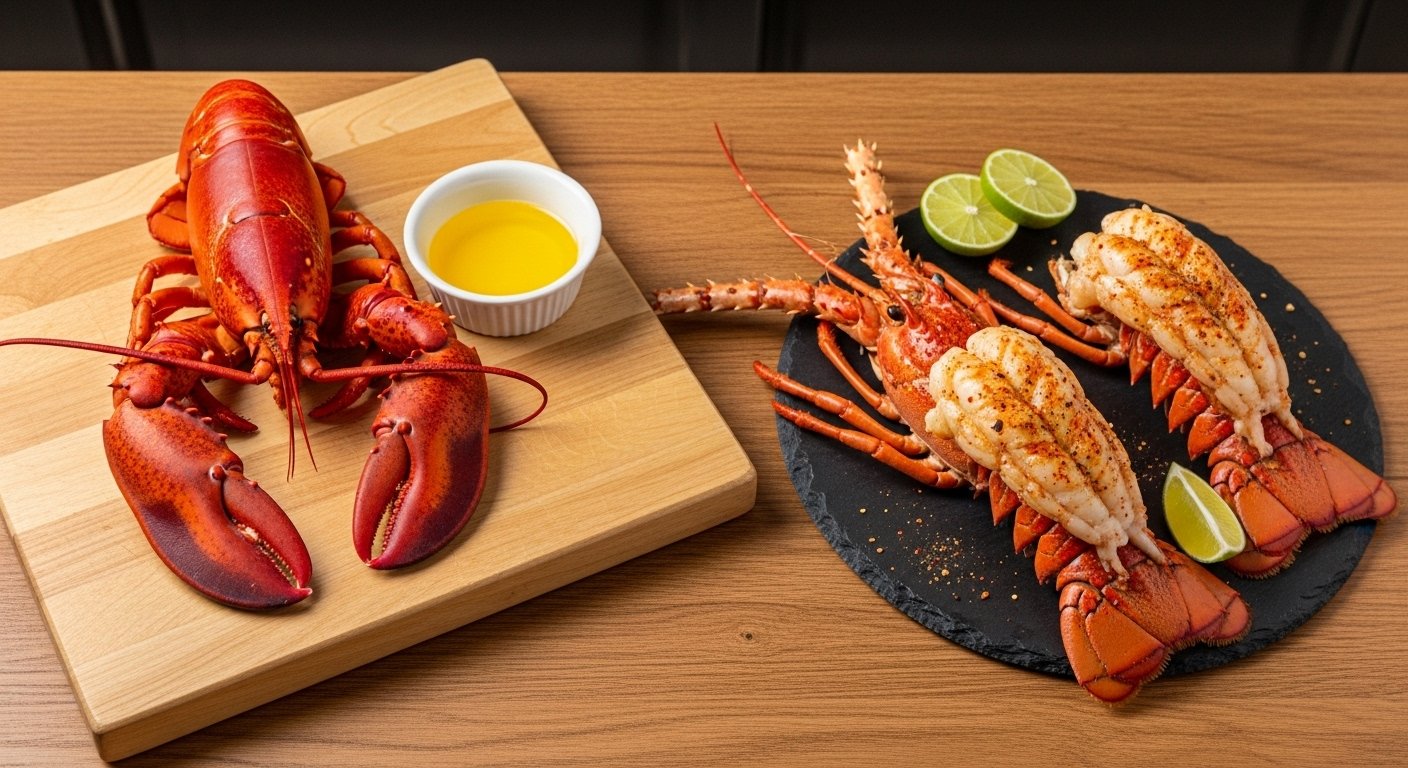As a chef, I’ve learned that not all ingredients are created equal, and this is especially true for lobster. The lobster world is largely split into two camps: the celebrated cold water varieties with their impressive claws, and the spiny warm water lobsters from tropical seas. While both have a well-deserved place in culinary arts, they differ immensely in flavor, texture, and how they behave in the kitchen.
This guide isn’t about deciding which lobster is definitively “better.” Instead, it’s about exploring their unique qualities from a chef’s perspective. Understanding what makes each one special is the first step to appreciating them fully and knowing exactly how to make them shine on the plate.
The Tale of Two Lobsters: Key Physical Differences
Where They Come From: Cold Atlantic vs. Tropical Seas
The environment a lobster comes from is the single biggest factor in its development. Cold water lobsters, like the famous Maine lobster, thrive in the chilly, deep waters of the North Atlantic and parts of the Pacific. These cold temperatures cause them to grow slowly, which results in firmer, more succulent meat. They are instantly recognizable by their dark, smooth shells that often have a striking blue-green tint before cooking.
Warm water lobsters, often called spiny or rock lobsters, are found in tropical and subtropical climates like the Caribbean, Florida, and off the coast of California. Their shells are typically lighter, more colorful, and covered in sharp spines for protection. They grow faster in the warmer seas, which contributes to a different texture in their meat.
The Main Event: Why Do Some Lobsters Not Have Claws?
This is the most obvious physical difference and a frequent question from diners. Cold water lobsters belong to the Homaridae family and are equipped with two large, distinct claws—a heavy crusher claw for breaking shells and a smaller pincer claw for tearing. From a culinary perspective, the tender, sweet meat from these lobster claws is highly prized and considered a delicacy.
Warm water lobsters, on the other hand, have no claws at all. Instead, they defend themselves with long, spiny antennae. Some diners see the lack of claws as a drawback, but as a chef, I see it differently. Warm water lobster tails are often larger and hold up beautifully to bold cooking methods like grilling or roasting over open flame. They may not offer the delicate claw meat of a Maine lobster, but they deliver hearty, meaty bites that shine in spiced dishes. It’s less about what’s missing and more about what you gain—the freedom to cook with intensity without worrying about overshadowing the flavor.
A Chef’s Guide to Flavor, Texture, and Taste
The Cold Water Profile: Sweet, Firm, and Buttery
The slow, cold-water growth of a Maine or Canadian lobster creates a truly premium product. The meat has a firm, clean snap and a succulent, chunky texture that holds together well when cooked. Its flavor is sweet, delicate, and kissed with brine—never overpowering. Different parts of the lobster offer unique experiences; the tail is dense and buttery, the knuckles exceptionally tender, and the claw meat the sweetest of all.
I’ll never forget one evening at Aroma Thyme when I served a whole steamed Maine lobster, simply presented with drawn butter and a squeeze of lemon. A guest leaned over to me and said, “Chef, this doesn’t taste like lobster I’ve ever had before—it tastes like the ocean itself.” That moment reminded me that with cold water lobster, less is more. When you respect the ingredient, it speaks louder than anything you could add.
The Warm Water Profile: Meaty, Robust, and Versatile
Warm water lobster meat, found exclusively in the tail, offers a different culinary experience. The texture can vary—sometimes softer and more delicate than its cold water cousin, other times denser with a heartier chew. Its flavor is also sweet but often more robust, seafood-forward, and occasionally described as fishier. That stronger profile allows it to stand up to bold seasonings without getting lost in the dish.
This makes warm water lobster a chef’s playground. I love grilling the tails over open flame with Cajun spices or slipping them into a Caribbean-style curry. They provide a meaty, satisfying bite that thrives in adventurous pairings where a Maine lobster might feel out of place.
Nutritionally, both lobsters are lean, protein-rich seafood options. However, according to the National Oceanic and Atmospheric Administration (NOAA), cold water lobsters generally contain slightly higher fat content, which contributes to their richer mouthfeel, while warm water lobsters are leaner, making them excellent for lighter, spice-forward dishes.
In the Kitchen: Culinary Uses and Cooking Techniques
Honoring Delicacy: How to Cook Cold Water Lobster
When you have an ingredient as refined as cold water lobster, the goal is to highlight its natural qualities, not to mask them. Simple cooking methods are often the best. Steaming or gentle butter poaching keeps the meat tender and preserves its sweet, briny flavor. This is why classic dishes like a simple steamed lobster with drawn butter, a creamy lobster bisque, or a traditional New England lobster roll are so timeless. They all respect the core ingredient.
Embracing Boldness: How to Cook Warm Water Lobster Tails
The robust nature of warm water lobster invites more adventurous cooking. Since its flavor won’t be overshadowed, it’s the perfect candidate for high heat and bold spices. Grilling is a fantastic method, as the flame adds a smoky char that complements the meat’s sweetness. Broiling with garlic butter and paprika is another excellent choice. If you want to know how to cook warm water lobster tails for a crowd, consider dicing the meat for spicy seafood stews, paellas, or even a luxurious lobster-topped pizza where it can hold its own against other strong flavors.
The Final Verdict: What Is the Best Tasting Lobster?
So, after all this, which one is truly the best? The honest answer from any chef should be: it depends entirely on the dish. There is no single “best” lobster, only the right lobster for the right preparation. Asking what is the best tasting lobster is like asking if a delicate white wine is better than a bold red—each has its perfect pairing.
If you desire that classic, sweet, and buttery lobster experience, a cold water lobster is unmatched. For a simple, elegant meal, it will always be the star. If, however, you’re planning on grilling with heavy spices or creating a rich, complex seafood stew, the hearty and robust warm water lobster tail is the superior choice.
To make the choice easier, here are the key lobster differences at a glance:
| Feature | Cold Water Lobster | Warm Water Lobster |
| Claws | Yes, with prized meat | No claws |
| Meat | Claw, knuckle, & tail | Tail meat only |
| Texture | Firm, chunky, succulent | Varies (softer to denser) |
| Flavor | Delicate, sweet, briny | Robust, sweet, seafood-forward |
| Price | Premium | More budget-friendly |
| Best For | Steaming, poaching, rolls | Grilling, broiling, spicy dishes |
A Chef’s Final Take
As chefs, we don’t always need to choose one lobster over the other. Instead, we learn to appreciate both for what they bring to the table. Cold water lobster is all about refinement; warm water lobster is a study in robustness. One whispers with delicate sweetness, while the other speaks louder with a hearty, sea-kissed flavor that stands up to intense cooking.
Ultimately, whether cold or warm water, serving lobster is about creating an experience. Some guests will always prefer the sweet tenderness of a Maine claw, while others will lean toward the satisfying chew of a grilled Caribbean tail. Both can be unforgettable when handled with respect. For me, the real joy is in understanding those differences—and letting each lobster tell its own unique story on the plate.








